Explore the ideal country, dream of returning to Nanzhao State, and be a dream thief of time in Dali (Shaxi, Xizhou, Weishan, Dali Ancient City)
I was sitting in my room, looking through your photo, which reminded me of Dali again
The sun is always bright, the sky is so blue, and the Cangshan Mountain is always green
I love the blue Erhai Lake, dotted with white sails, and my heart beats slowly with the wind
Under the golden sunset, in the green fairy grass, how warm your smile is
--"Warm" Xu Wei
The fifth time I came to Dali, I realized that Dali is far more than Dali
After coming to Dali for the fifth time, I wondered why I always missed it before.
In my impression, when I mention Dali, I only think of the small place around the Erhai Lake. In the past, my obsession when I came to Dali was to watch the rolling clouds and clouds by the Erhai Lake, but I missed the "ideal country" that was far away from the Erhai Lake. I didn't move north or south until I visited the Erhai Lake. Coupled with my favorite Xizhou and the iconic ancient city of Dali, these four ancient towns are Dali treasures and worthy of the world!
When I was young, Dali, Yunnan was a dream for many people. I had already fallen into a dream and didn't want to wake up. I listened to folk songs to accompany me.

"One·Ancient City of Dali"--Find a city by the Erhai Lake
"If you can't find someone you like, you might as well find a city near the Erhai Lake."
The first time I heard this sentence, I was already moved.
This is my fifth time in the ancient city of Dali, and the feeling has not changed. I still feel very comfortable here, perhaps because of the bright sunshine of Dali, or perhaps because of the light wind and clouds of Dali.

Although it is a relatively popular scenic spot, the literary and artistic atmosphere here is unique to the ancient city. In the high walls on all sides, you can go shopping in a daze, pick flowers and wine, or stop somewhere to listen to songs.
You are no longer a passer-by.

The handmade shops, food stalls, bars or inconspicuous small shops scattered in the corners of the ancient city are all a sight.

At the foot of Cangshan Mountain, facing the Erhai Lake, flowers bloom in warm spring.

It won't be long before you find cherry blossoms in full bloom next to the street. Walking on the uneven stone slabs, your heart will become lighter.
If you are not satisfied with life, you might as well head west to Dali.
Millennium Ancient Building| Wuhualou
When it comes to the ancient city of Dali, what buildings do you think of first?
As long as you walk on the main street of the ancient city, you can see this conspicuous attic. It is a landmark building in the ancient city of Dali and even Dali ~

The buildings of the ancient city of Dali are made of green tile roofs, which looks very simple.
In the center of the ancient city that has experienced more than 1200 years of vicissitudes, a grand and exquisite building supported by four pavilions and surrounded by clear streams is the famous Wuhua Building in the history of Nanzhao and Dali.

It is located in the middle of Fuxing Road and is one of the landmark buildings in the ancient city of Dali. It is exquisite and magnificent.
In ancient times, Wuhua Tower was a place where official gatherings and banquets for distinguished guests. It was five-story high and could accommodate tens of thousands of people to stand.

However, in history, Wuhua Building has been burned down several times and rebuilt several times, going through thousands of vicissitudes. The current Wuhua Building was rebuilt in 1998. It is a four-story building more than 10 meters tall. The lower floor is a pedestal and the upper three floors are buildings.

Wuhua Tower is one of the more magnificent buildings in the ancient city. You can climb the building and overlook Cangshan Mountain and Ancient City.
Especially when the lights are first on at night, the Wuhua Building is particularly beautiful.
When Bai buildings meet Jesus| Catholic Church
I believe that 90% of the people who have visited the ancient city of Dali do not know that there is a church hidden in the ancient city, which is also the most worthy religious building in the ancient city.
When the Bai folk houses met Jesus, the ancient city of Dali seemed to have a layer of mystery.
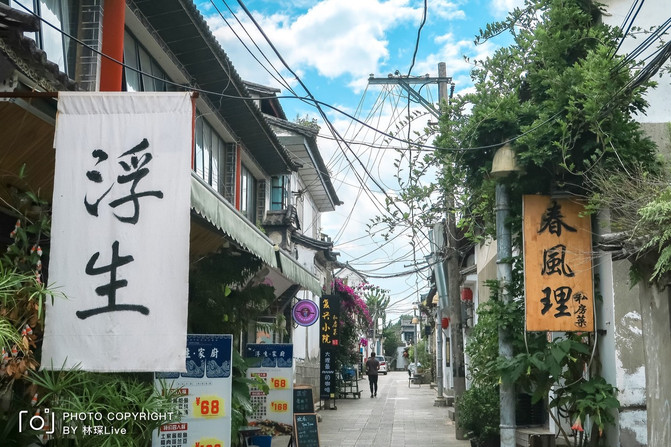
Hidden in the alleys of Renmin Road is the most distinctive building in the ancient city of Dali-the Catholic Church.
If you are tired of the people coming and going in the ancient city, why not follow me to this rare quiet place, which stands quietly in the crisscrossing streets of the ancient city.

If it weren't for the words "Catholic Church" written on it, you wouldn't have discovered that there would be a Catholic church here.
It is not the traditional European Catholic church you imagine. Although it was a masterpiece of European missionaries in the 20th century, it coincided with the opportunity of "Sinicization" and the missionaries built it into a "Chinese style", or to be precise, a Bai style.

This church with a distinctive Bai style is called Shengsantang. The Chinese corners are raised high, like a pair of spread wings. Under the flying eaves are exquisite stone carvings and gorgeous color paintings. It is very beautiful.
The vermilion columns and red arches are standard Chinese red, and the stacked arches above the door can be called living fossils of ancient Chinese architecture. The couplets on the door include both Catholic colors and traditional Chinese couplets that emphasize antithesis. The blend of Chinese and Western cultures complements each other.

This is the place where the French should come most, because their ancestors brought Catholicism to Yunnan more than a hundred years ago, and it was the French who created the Holy Trinity, which combines China and the West.
More than a hundred years later, French tourists exclaimed in front of this Chinese-style Catholic church. Dali's diverse and inclusive culture seems to have not changed, just like this wonderful church, it has always stood tall.
Warm a city with a bookstore| Dafang Bookstore

This is a bookstore I stumbled across while walking through the ancient city after dinner. Before coming here, I didn't know there was such a large bookstore in the ancient city.
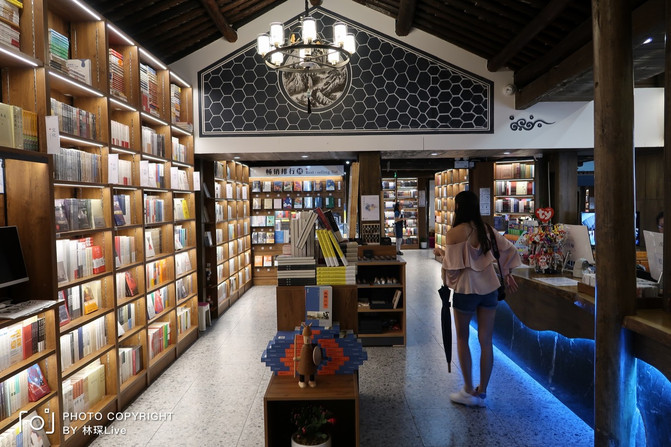
Entering, I found that the inside was very spacious. From the outside, it felt like it was a small bookstore.

Dafang Bookstore, formerly known as Zhonghua Bookstore, was built in 1993 and was officially established in 2014. "Generosity" comes from "Zhuangzi·Autumn Water","I always see laughter in the family of Generosity". It originally refers to people who understand the great truth, and later refers to knowledgeable or knowledgeable insiders.




There are many exquisite small objects and stationery inside, and the layout is also very warm. It feels warm when you walk here.

I like to enjoy the slow time in Dali, like the warmth of coffee in my hand, and like the tranquility of being alone.

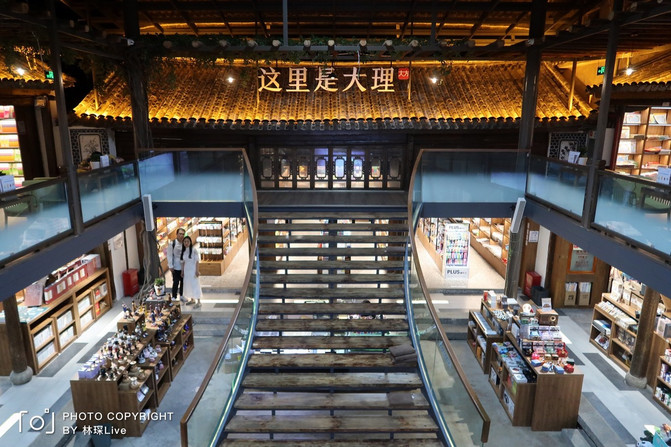
The central area of the bookstore is the most beautiful, especially the stairs leading from the first floor to the second floor. You must check in when you come here. The iconic characters on the second floor,"This is Dali", make people feel the enthusiasm from Dali.
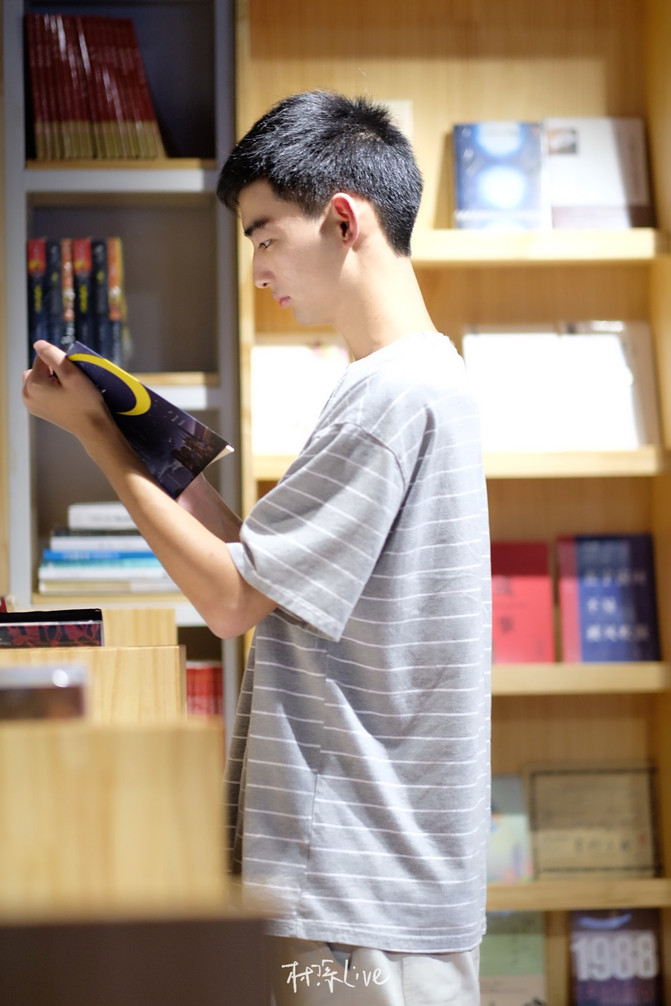
The fragrance of books in the flower language of the forest, I am waiting for you in Dali, Dafang is waiting for you in Dali.
Meet the Academy deep in the alley| Wutong Academy
In addition to Dafang Bookstore, there is also another very small and quiet bookstore hidden in the ancient city, which is very low-key.

There is a erected sign on the roadside, and you can reach it by walking 20 to 30 meters into the alley at the corner.

This alley is very quiet, and few tourists will go here. It also has a feeling of happiness.

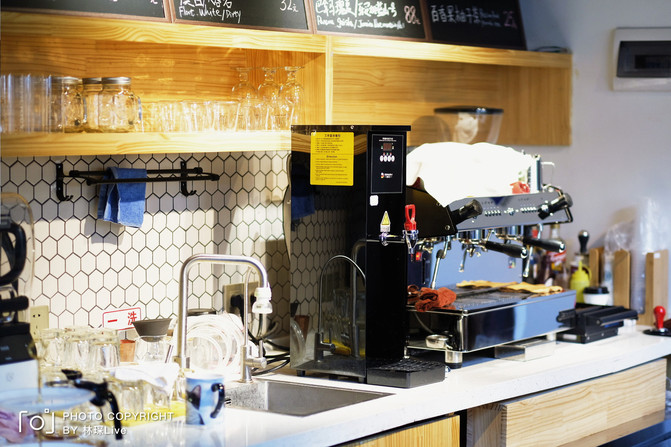
Walking into the door, there was a small courtyard inside. There was a drink seller on the first floor. I took a glass of lemon and went to the library. When I went there, I was surprised to find that there was no one inside. The whole room seemed to be contracted by me.



There are poetic windows, wooden desks, bright lights, and the atmosphere is quite good.
It would be good to stop here halfway and chat while drinking a drink. The most important thing is that there are few people, so you can enjoy the tranquility here.
I only know the scenery, but I don't know the famous literature| wenmiao
In the ancient city of Dali, walk along the main road Fuxing Road, and you will see a building with flying eaves and arched arches. It is the Dali Confucian Temple.

Although the Confucian Temple is located in a lively location in the ancient city, there are not many tourists. It is a good place to take peace in the busy city, especially in the morning. It is particularly clean and cool inside, and you can enjoy a moment of tranquility.

The Dali Confucian Temple faces west and east, with a symmetrical overall central axis. It is in a progressive layout one by one. The architectural style is mainly antique wooden structures, reflecting the architectural style of the Dali Bai people.
Dali Confucian Temple was a temple of ancient Confucius that had dual status as a prefecture and a county in Dali. It was also a landmark building in the ancient city of Dali.

You can see this bridge called the "Zhuangyuan Bridge" when you walk into the gate. It is said that in ancient times, only those who won the Zhuangyuan examination could cross this bridge, and others could only bypass it from both sides. The pool under the Zhuangyuan Bridge is called the "Pan Chi". In ancient times, there was a saying in front of schools to revitalize studies.

The Confucian Temple is also called the Confucian Temple. What we see today is the restored one. The traditional Chinese culture with it as the carrier has unique and rich connotations, has had a profound impact on Dali, and is a historical witness of Dali's "famous literature country".
Walking around every corner exudes an antique atmosphere.

There are also many wishing signs in front of the main hall. Every year, many parents of students come here to make wishes and pray for their children.

Walking in the Confucian Temple, there are sporadic passers-by, and traces of the past are left on the simple walls, silently telling the glory of the past.
It is both the Shuaifu and the miniature version of the Forbidden City| Dali City Museum
99% of people don't know that the Dali City Museum is located in the ancient city of Dali!

This place was discovered by accident by passing by. The museum sites were formerly the Yamen of the Yunnan Prefectural Office, Du Wenxiu Marshal Mansion, the headquarters of the Seventh Column Detachment on the Diannan-Guangxi-Guizhou Border, and the offices of the West Yunnan Working Committee in the Qing Dynasty. Therefore, there is no direct inscription on the lintel of the Dali City Museum.


Even if it is not peak season and weekends, many people come to the museum. The well-organized houses and rich vegetation are like walking into a large courtyard.

Relying on the advantages of the core of the ancient city and maintaining the original architectural style of the Qing Dynasty, the Dali City Museum integrates rich displays and exhibitions with the exquisite ancient garden architecture, like a miniature version of the Forbidden City.

The museum covers precious cultural relics from the Neolithic Era to modern times in the Dali area, with nearly 10,000 remains. It has six fixed exhibition halls: "Historical Cultural Relics Exhibition","Ming Dynasty Pottery Figurines Exhibition","Buddhist Art Exhibition","Ancient Painting and Calligraphy Art Exhibition","Yunnan Prefect Historical Evolution Exhibition" and "Du Wenxiu Uprising Photo Exhibition", together with the expanded Forest of Steles exhibition area, making it a unique physical database for studying Dali's history and culture.

The vermilion walls in the museum make people feel very simple and simple. They are also called the "Forbidden City Red", especially when the sun shines in and the shadows of the trees are dancing and full of poetry.
It is different from the solemnity of other museums and has a garden-style design. It can be said to be very Dali.
Dali Ancient City Cuisine
Every time I come to Dali, I can't help but go to the ancient city to collect delicious food, so I specially organize it for everyone!

① Snack recommendations
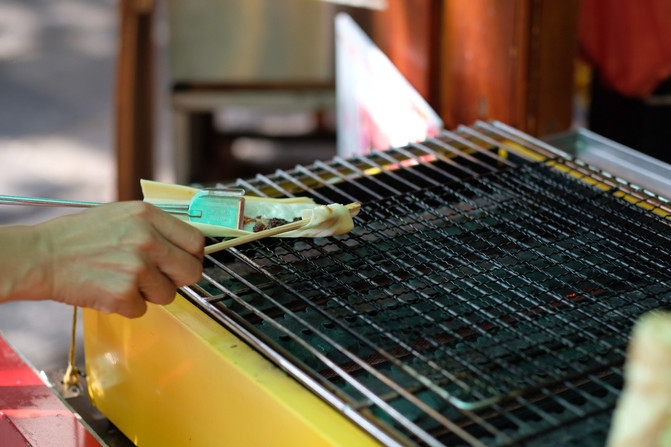
Milk fan is a fan-shaped dairy product mainly produced in Dali. It is also a specialty of Dali. It is a thin sheet with less water. It is milky and milky yellow in color, roughly like a water chest-shaped bamboo fan with grips at both ends.
It can be eaten raw, fried, roasted, or cold. What the 18 Monsters of Yunnan said: "Eat with fried milk" is actually talking about milk fans. The picture is a roasted milk fan bought on the street ~

Yunlong Roll Noodle is a famous snack in Yunlong, Dali. I bought it on Fuxing Road. The roll Noodle is glutinous and super Q bombs. It is not expensive for ten yuan a serving. It has a rich taste of sweet, sour, salty, spicy, and shredded peanuts.~

Yangbi Roll Noodle is a specialty snack in Dali Yangbi. It looks somewhat similar to rice noodles. It is made of high-quality rice. The roll Noodle is delicate in texture, has a sour, spicy and sweet taste. Coupled with the mellow feeling brought by walnut sauce, it has a unique flavor.

Flower cake is the most representative delicacy in Yunnan. It is a shortcake made with Yunnan's unique edible roses. Many people who come to Yunnan to travel will buy flower cakes and take them back to eat them. My mother especially likes them.

② Recommended restaurants
I only recommend one of the gourmet restaurants in the ancient city. It is an ancient style restaurant. You can eat many Yunnan specialties here. I think it is great regardless of the environment or taste. I have already visited it for the second time!
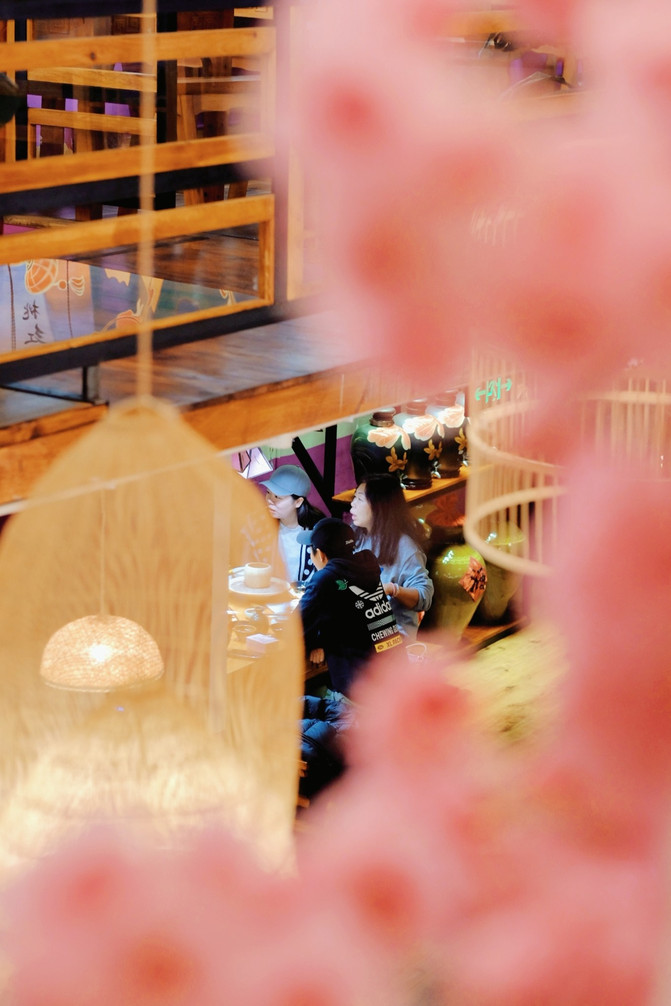

It was in a small alley next to Renmin Road. After playing for a day and returning to the ancient city and when the lights were first on, I passed by and found this small shop.



The restaurant is very ancient and ancient, with cherry blossoms decorated facades, secret recipes, wooden pavilions, paper lanterns, and guzheng gongs and drums. It is really ancient. It is even more beautiful to take pictures wearing Han costumes and travel through ancient times in one second ~
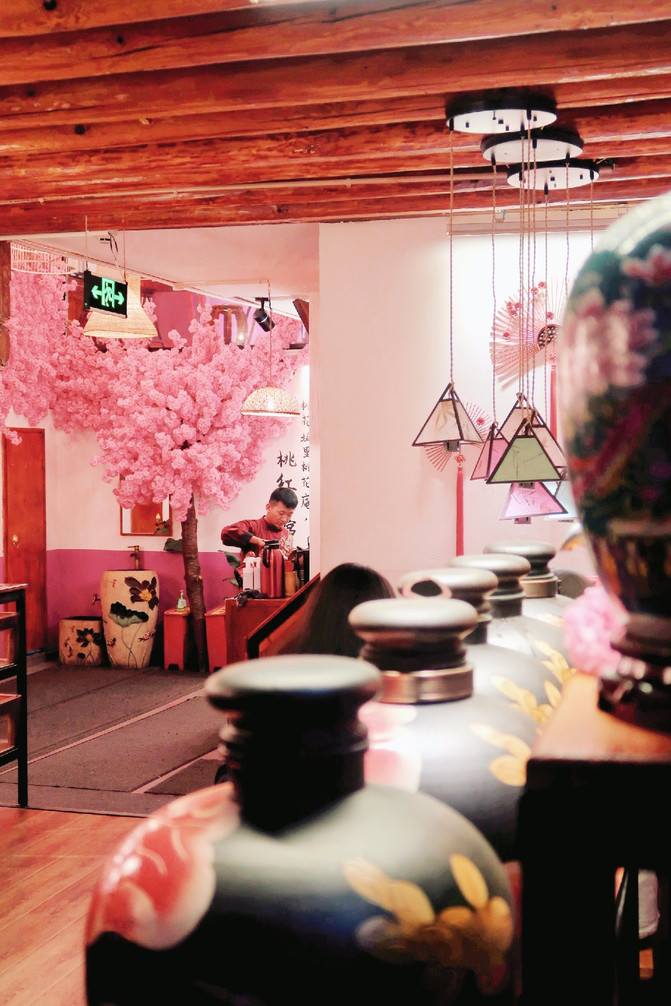
This house has two floors in total. The outside feels very small. When you enter, you find that the inside is very big and spacious. There is a big wine can at the entrance of the first floor, and you can smell the aroma of wine when you enter.

I didn't expect the food in this restaurant to be as amazing and fairy as the restaurant environment ~

The shape of the emerald rouge snow flower fish is full of marks. It is a signature of the house. The amount is very large. The fish is tender and smooth. It looks very appetizing. There are also pebbles inside ~

Dali Mekuai Spicy Chicken is not as strong as Sichuan and Chongqing. It is moderately spicy and suitable for everyone's taste.

The flowers and snow moon must be on!!! This name is too Yunnan. Of course, you have to drink a few glasses at night when you come to Dali. This is a home-brewed wine. There are two flavors, one is peach blossom wine and the other is plum wine. It is just right to drink until you are slightly intoxicated.

Boasting about the special paoluda, just order it and it's over. My friends love it so much. If it's not delicious, come to me?

When we left, his family also sent each of us a homemade hand-drawn map of the ancient city of Dali. I like it very much. I still keep this map.
"2·Xizhou Ancient Town"--Like, Love, Joy, Xizhou
I like Fang Qi's praise of Xizhou:
"How can I tell you what Dali is?
Use the sound of the Xizhou wind blowing on the wheat waves to explain...
Do you think it's okay?"
Speaking of Dali, apart from Erhai Lake, the thing that reminds me most first is not the ancient city of Dali, but the ancient town of Xizhou.
Every time I come to Dali, I will never miss Xizhou, and I feel that I will never get tired of going. It does not have the excitement of the ancient city of Dali, but more of a subtle and restrained beauty.
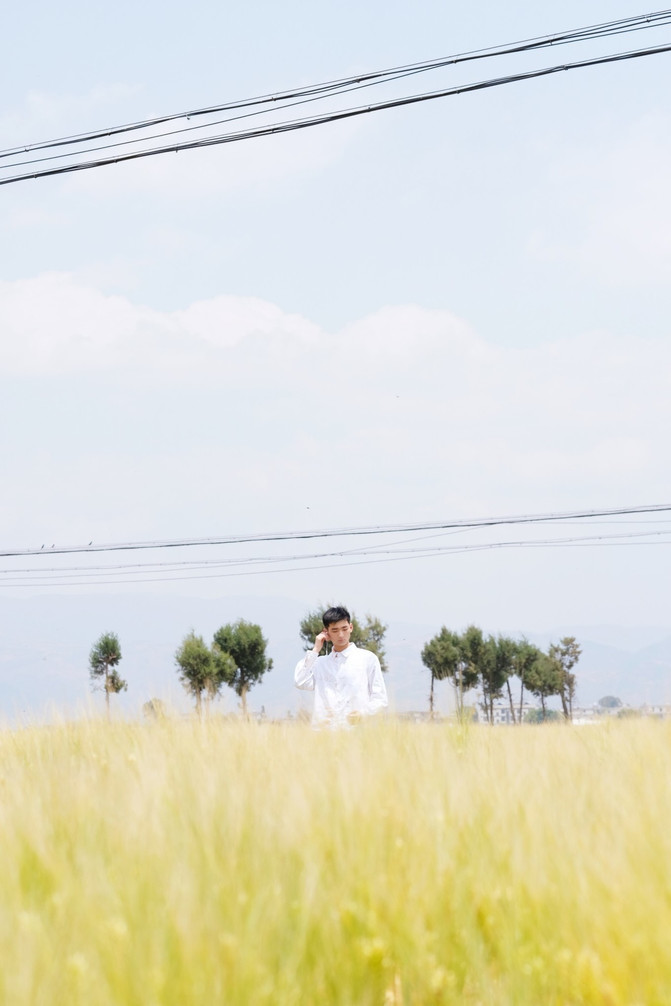
Xizhou yellow-walled wheat fields, the years are quiet and good| xilinyuan

I really love the yellow walls of Xilin Garden. Every time I pass by, I take a few photos. Under the gray old tiles, the rolling outer walls are painted orange, reflecting the blue sky, white clouds and endless rice fields, like a natural ink painting.

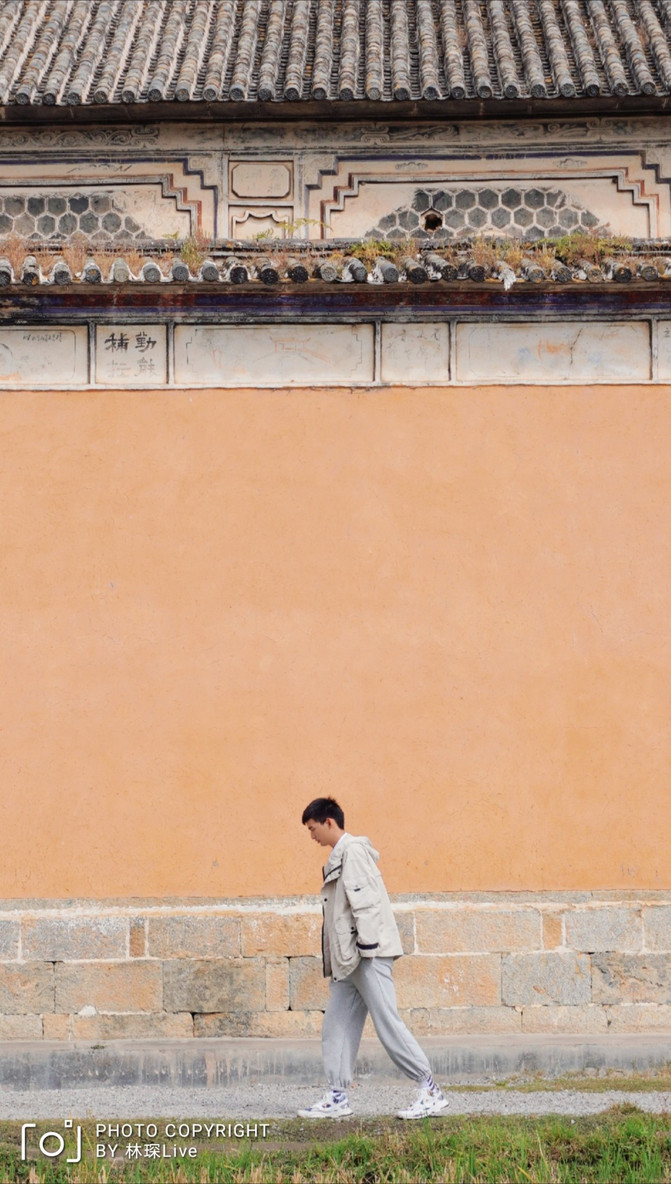
It's very interesting to take pictures when you change your pose here. If you take a group photo with several people, it's very interesting to pose together in a funny pose ~

It's also good to record a small video here. Many photographers who come to Dali to shoot videos will also choose to take pictures here.


This is Xizhou in spring. There are rapeseed flowers outside the walls. In autumn, there are rice fields.
Meet you around the corner| Yuanyulou
Corner Building can be said to be a must-check place in Xizhou. It is also a landmark building in Xizhou. It is located at No. 119, Shiping Street, Xizhou Ancient Town, Dali. It was originally the old house of Yang Ruxuan, a villager in Chengbei Village, Xizhou. It was built in 1945. It is the most unique historical building in the ancient town of Xizhou.

The location of the corner building on both sides facing the street, the concept of foreign houses, the design of a combination of Chinese and Western and the choice of arc-shaped appearance have inadvertently left a miraculous building for Xizhou Ancient Town, creating a new tourism opportunity for today's Xizhou Ancient Town. A very popular online celebrity check-in point.

If you want to take photos, I suggest going there at 10 a.m.. There are not many tourists. It was noon when I went, and the queue here was already starting to take photos ~
Blue and white romance, come here to be in a daze| Lanxu Tie-Dye Store
I have been to Xizhou several times before I came here to check in. I highly recommend this tie-dye shop in Xizhou Ancient Town. Many people come to Xizhou specifically to come here.

It is in an inconspicuous alley in Xizhou, and it is on the right hand side at the end.

You can visit it for free at no extra charge. The owner of the store is very kind and welcomes everyone to visit.

Here you can learn tie-dyeing, have a drink, or just go and take photos. It's okay!

The tie-dye shop has two floors in total, with a small courtyard and a small balcony. The first floor has an experience area based on blue tie-dye, and the second floor overlooks the small fields of Xizhou.



Glass windows, round arches, and small rooftops are all good places to take photos and check in. I suggest that if you want to go there in the morning, there will be more people in the afternoon.
Hayao Miyazaki's wheat fields really exist| Kelizhuang
Have you ever seen the shape of the wind or heard the sound of the wind blowing on wheat waves?
The comic-like scene of the wind blowing the wheat waves really exists in Xizhou!!!

This wheat field is located on the roadside of "Kelizhuang" near Xizhou Ancient Town. Navigation "Kelizhuang" and you can reach it along the Dali Line, just by the roadside ~

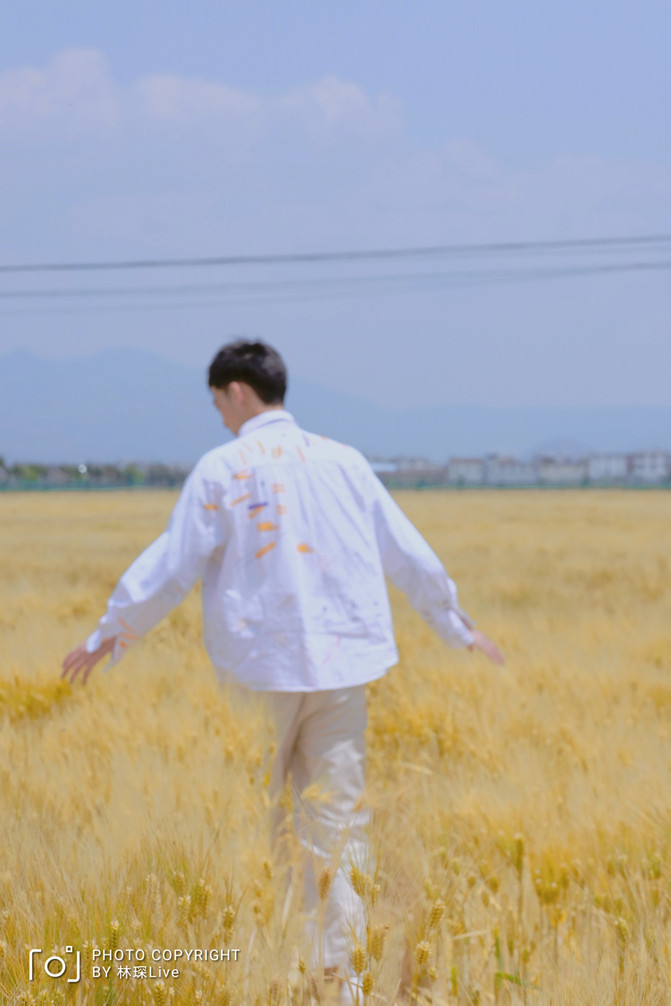
There is a charge to take photos here, but it is not expensive by 10 yuan/person. There is no time limit to take photos until you are tired!

The young lady next to me is very cute. Remember to bring more props when you come here to take photos, otherwise you will not be able to take many photos like me, haha, such as easel, kite, butterfly net, etc.

If you are here to take pictures of wheat fields, it's best to go before April. The feeling of wheat swaying in the wind will only be dreamy if you have seen it with your own eyes ~

But first of all, it was stated that this piece of wheat was originally fallen, and it would be very obvious if it was lying down in the wheat field, but it was still recommended that everyone try not to step on the wheat.

If you are wrong, make an appointment to come here next spring ~
Xizhou Cuisine
There are basically all the ancient cities of Dali in Xizhou. In addition to roasted milk fans, bait nuggets, etc., the most noteworthy thing is Xizhou Baba!

There are two flavors: sweet and salty. When making, use two layers of charcoal fire, the upper layer of charcoal fire is fierce, and the lower layer of charcoal fire is slow fire. Brush lard on the prepared dough blank and then put it into the pan for baking. Brush the grease several times during the baking process, and bake until fragrant.

"A Bite of China" was filmed in Xizhou, so you must try Xizhou Baba when you come to Xizhou ~

Xizhou Baba used to be very cheap, but with the development of tourism, the price has also increased.

In addition, I would like to recommend a few restaurants that I think are good, Guzidi Garden Restaurant, Ah Ma Ying Pea Powder, and Jiyisi Cafe. You will definitely like it ~
"III. Weishan Ancient City"--Fireworks in the world, the ancient capital of Nanzhao
Because of the existence of the ancient city of Dali, this ancient city of Weishan, which lives hundreds of miles away, has become a lost place and a rare pure land in Yunnan.
Time has faded away the prosperity of the ancient city, but it has retained the rare original appearance in the world.
When I set foot in this ancient city with a history of more than 600 years, I would regret that I had come to Yunnan many times and discovered this treasure town so late. Before I started writing, I would start to struggle with whether to share it, because I liked its aloof temperament so much that I was afraid that more and more tourists would become the ancient city of Dali today and lose its original flavor.
When I took the video and posted it online, someone said that I wouldn't recommend it and there would be no place to stare in the future. Sometimes this mentality was quite contradictory, but even if I didn't share it, other people would come and share it, and I couldn't protect it. It wouldn't be commercialized. Let me show it the most beautiful way in my mind and let the world know that Yunnan today can still be Yunnan in the past.
There is nothing other than fireworks in the world, mountains and rivers are far away.

Birds sing and flowers fragrance in Mengyangzhong| Mengyang Park
The first stop on Weishan was Mengyang Park. In fact, this was not in our plan. We only learned later that this place was called Mengyang Park.
Because Mengyang Park is next to the parking lot, I came here by accident. (You don't need to look at the map when you come to Weishan. Just stroll around. You may have surprises.)


This is the favorite place for locals. They like to call Mengyang Park the "Big Park". The former "Small Park" was next to Mengyang Park, but now it has been changed into a square, so this "Big Park" is the only park in Guhao.



It is not a tourist attraction, but it is very lively. Women water flowers, elderly people exercise, children running... Coupled with the pleasant climate here, the singing of birds and the fragrance of flowers, this is the first time I feel that the atmosphere of the park can be so good.

When you come here, you will find that the trees here are full of bird cages. There are many bird farmers in the ancient city of Weishan. Walking birds in the morning is a must-do thing for them every day. It is as common as we have to eat every day. It has been integrated into their lives.
There is never a shortage of bird chirps here. Here, you can really be called by the sound of birds in the morning.]

Weishan Library is also located in Mengyang Park. This environment in the park should be an ideal place to read.


Mengyang Park has a history of nearly a century. There are well-preserved ancient buildings such as Yanta Square, Chongsheng Temple, Zunjing Pavilion, Minglun Hall, etc., as well as many famous trees and ancient trees. The culture is profound and different from other ordinary parks. This is also its charm.
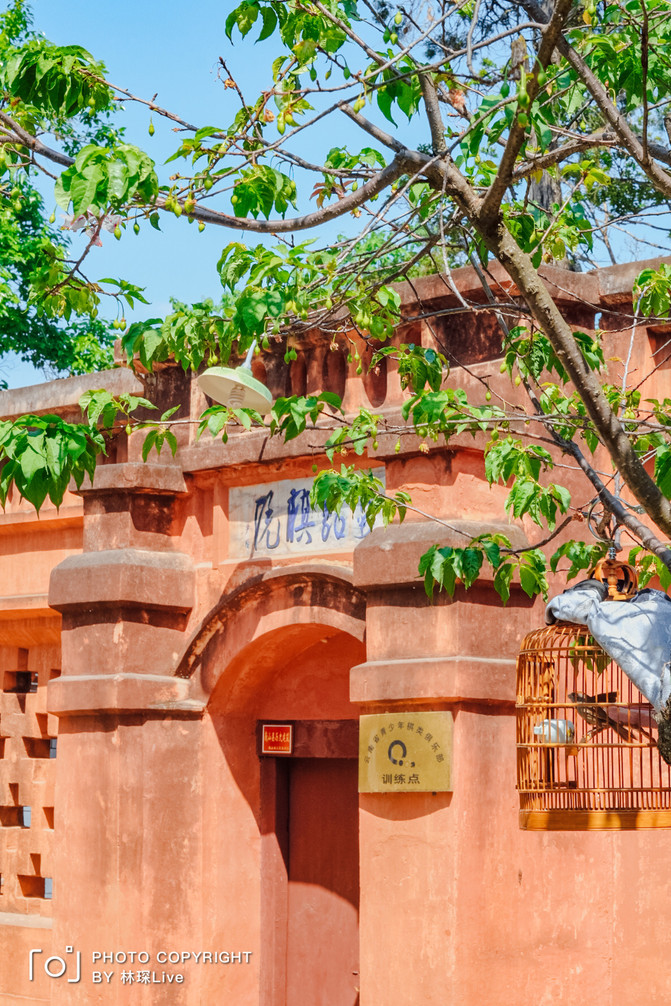
You will see the red-walled building in the park. It is the "Nanzhao Chess Academy", formerly the "Qin and Chess Club". It was founded in 1938. Its original main function was to carry out piano and chess activities, and later changed its name to Nanzhao Chess Academy. There are many chess masters hidden in Weishan.
The Chess Academy still maintains its historical pattern well and has a quiet environment. When there were no chess games and competitions, it was also a prosperous tea shop.


Famous trees and ancient trees, pavilions, ponds and promenades, green plants and flowers, you will forget your troubles and enjoy the moment of tranquility, soak in tea, and soak in the park.
The majestic ancient historical capital of Nanzhao| Nanzhao Museum
You must visit Nanzhao Museum when you come to Weishan Ancient City! If you want to uncover the mystery of the ancient Nanzhao country, you might as well start here. It is very suitable as the first stop on your trip to Weishan.

Nanzhao Museum is located in Baoguo Street, the ancient city of Weishan. It was completed in 2015 and opened the following year. It is an art palace that integrates modern museum displays and ancient architectural displays.

The first building you see when you walk into the gate is the preface hall of the museum. Just like a book requires a preface, the preface hall highly summarizes the exhibition content and explains the historical background of the exhibition, which is equivalent to an overview of the entire exhibition hall.

The "Nanzhao Tu Zhuan" painted on the dome ceiling at the top of the preface hall is very eye-catching. It records the detailed history of Nanzhao and is also the earliest preserved painting art work in Yunnan to date.
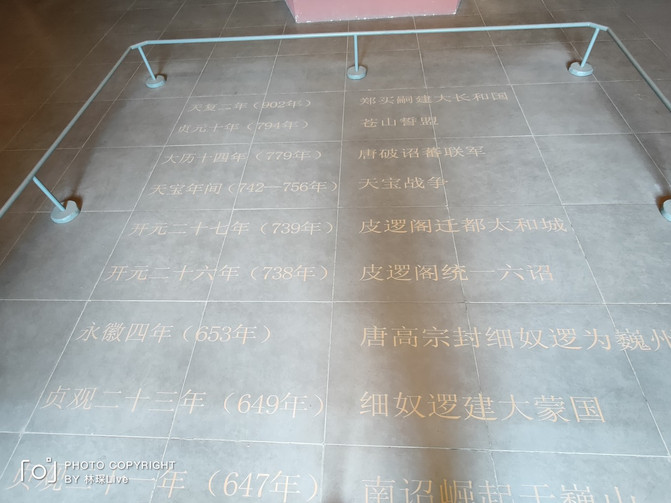
The ground in the hall is engraved with more than 100 years of Nanzhao's history from its creation to its disappearance.
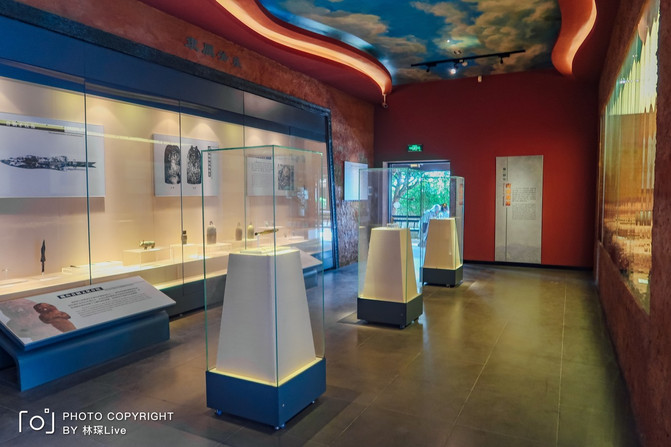
There are many cultural relics exhibition halls next to the preface hall. Swords, pottery pots, jewelry, etc. are all relics of the early Weishan civilization. Although the collections are not many, they are all the essence of Nanzhao culture.

There are many answers to the history of Nanzhao.

During the Tang Dynasty, there were many small countries in the Erhai Lake area in Yunnan, and they did not serve each other.
Among these small countries, Mengyu Zhao, Yuexihao Zhao, Langqiong Zhao, Yuexihao Zhao, Shilang Zhao, and Mengshe Zhao are the strongest, and are known as the "Six Edict" in history. Among them, Mengxizhao is located in the area from the north of today's Weishan County to Yangbi County, Mengxizhao is located in the area of today's Dengchuan County, Langqiong is located in the area of today's Eryuan County, Shi Langzhao is located in the area of today's Qingsuo Township, Yuexizhao is located in the area of today's Binchuan, and Mengshe Zhao is located in the area of today's Weishan County.
Although these six small countries are independent, Mengshe Zhao is undoubtedly the most powerful among them. Because it is located at the southernmost tip of the six zhao, it is also called "Nanzhao".
With the support of the Tang Dynasty, King Piloge of Nanzhao unified the six decrees and moved the capital to Taihe City, beginning the real Nanzhao State.

Compared with the collections displayed in the museum, the architectural beauty of the museum is more fascinating and retains the mark of the past.

Dengjue Temple, Taiyang Palace, Lingong Temple, Zhaozhong Temple, and Dengjue Temple Twin Towers are important parts of the Nanzhao Museum building. The construction of the Sun Palace is the most magnificent, simple and profound.

The Taiyang Palace was built in the 16th year of Yongle of the Ming Dynasty (1418). It was built useless by the prefect and temple monks of the Mongolian Dynasty. It was repaired in the Ming and Qing Dynasties. The entire building was made of thick materials, completely preserved, and superb architectural craftsmanship. It is an important physical example for studying wooden structures in the early Ming Dynasty and has extremely high cultural relics value.
There are two doors on both sides of the inside:

Hundreds of longevity painting door:
There are six separate doors (two are missing), each door being 54 centimeters wide and 245 centimeters high. The grid hearts of the first five doors are all based on the eighteen seal engraved characters "Shou" as the theme, and the last door is composed of the characters "Ten Shou" and the production date of "Yihai Mid-Autumn Festival at Huanjidan", which finally formed a complete The skirt of the door of the "Hundred Shou Tu" is decorated with carved themes with auspicious signs such as "Magpie Climbing Plum","Phoenix Wearing Peony" and "Cormorant Lotus". The carving is excellent and has profound meaning, which is amazing.
The door to this hall reflects the forward-looking and realistic nature of the owner's philosophical thoughts on health preservation. The "Hundred Longevity Painting" is very rare to be displayed in the form of separate doors and seal cutting and carving. It forms a landscape that promotes excellent traditional seal cutting art and promotes the essence of ancient Chinese health culture theory. It is a collection of the essence of elegant making and seal cutting art., a unique traditional cultural seal cutting art treasure.
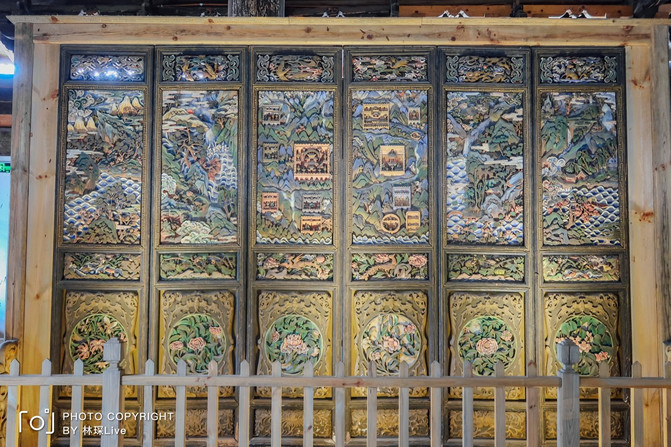
The door next to Minglun Hall:
This is a complete and exquisite masterpiece of wood carving in the Ming Dynasty. There are six fans in total, each fan is 294 cm high and 70 cm wide. It is divided into five carving sections from top to bottom. The top is the dragon, phoenix, crane, tiger and other auspicious beasts; The second is the main picture. The four fans on both sides are engraved with the scenery of spring, summer, autumn and winter respectively, and the two in the middle are engraved with mountains and rivers and castle temple towers; the following three sills are engraved with flower patterns. The carving technique combines embossed and open carving, with gorgeous colors, distinctive layers and scattered patterns. Towering mountains and rivers and majestic waterfalls, winding rivers and mountain village houses shaded by green trees, surrounded by clouds and mist, small bridges and flowing water, and flowers are competing in the open all year round, evolving the scenery of the four seasons vividly into it, filled with the atmosphere of peace and tranquility and vitality.
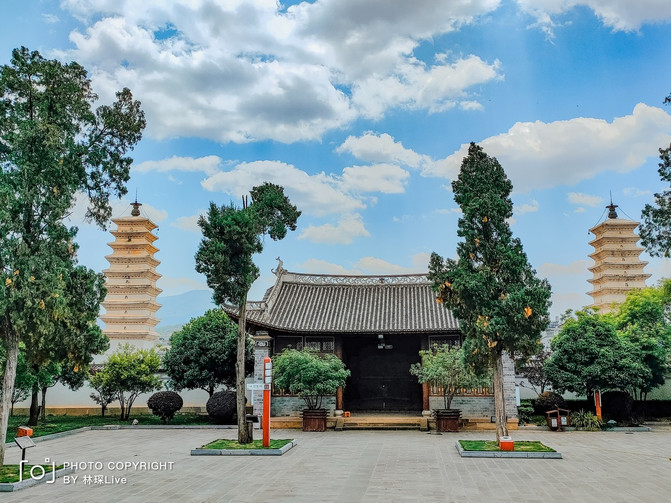
The Twin Towers of Dengjue Temple are located directly south of the Sun Palace. I think it is extremely beautiful. The golden sunshine makes the twin towers more mysterious and majestic. The wind chimes hanging on the tower have a deep Zen sound, which makes me especially enjoyable.
After going through vicissitudes, the palace walls are thousands of high| wenmiao
The ancient city of Dali has the Confucian Temple of Dali Ancient City, and the ancient city of Weishan also has the Confucian Temple of Weishan Ancient City.

Weishan Confucian Temple is separated by a wall from Mengyang Park in the ancient city. It has Dacheng Gate, Dacheng Hall, Yanta Square, Chongsheng Temple, Minglun Hall, Zunjing Pavilion, etc. It was not only a place where ancient officials made pilgrimage to Confucius, but also a place where scholars entered the exam to gain fame during the imperial examination era.

There is a street directly opposite the Confucian Temple. There are Lantern Street and Paper Umbrella Street. It is very beautiful under the sunshine and seems to welcome tourists to the Confucian Temple.

The Confucian Temple is large in scale and covers an area of about 10000 square meters. It is sitting north to south, with a light wall in front of it and a marble plaque of "Ten Thousand Rens Palace Wall" inlaid on it.
"Wan-Ren Palace Wall" comes from The Analects? Zi Zhang: "The master's walls are several feet high, but you cannot enter through the door. You cannot see the beauty of the ancestral temple and the wealth of all officials. There are probably few people who have access to the door." Later generations built a "ten-thousand-foot palace wall" in front of the Confucian Temple to symbolize Confucius's profound knowledge, high virtue, and profound thoughts, which was beyond the admiration of ordinary people.

After bypassing the "Wan-Ren Palace Wall", you can see this small arch bridge and small pool.
According to the ancient system, the learning of the emperor was a circular pool, called Piyong; the learning of the princes was a semicircular pool, called Panchi or Banbichi. Later, people called entering school as Rupan, which was the main feature of the Confucian Temple architecture.


The bridge of Banchi is also known as the "Zhuangyuan Bridge". It is said that in ancient times, only those who won the Zhuangyuan examination could cross this bridge, and others could only bypass it from both sides.

Continue to walk towards the central axis of the Confucian Temple and you will see this "Lingxing Gate".
It was an important sacrificial building in ancient times. It was first recorded in historical records that Emperor Gaozu of the Han Dynasty ordered the worship of the spirit star. Later, he first worshipped the spirit star on the occasion of offering sacrifices to heaven. The ancients believed that the spirit star was the "celebration of the lord's achievements" and was a star specially designed to manage officials. In the Song Dynasty, a Lingxing Gate was placed on the outer wall of the platform for offering sacrifices to heaven. Because it was shaped like a window lattice, the word "spirit" was changed to "lattice".
The Lingxing Gate opens up the righteous road on the left, and the ceremonial gate on the right.

After the Lingxing Gate is the Dacheng Gate, also known as the Yi Gate and the Halberd Gate. The ceremonial gate means that anyone entering this gate should be neatly dressed and well-behaved to show respect for Confucius.

The halberd gate shows majesty, but also shows a higher specification, which is used to represent the door of a dignitary's house. "Dacheng" is Mencius's evaluation of Confucius.


It was very quiet inside. There were not any tourists when I went, which made you want to sit at the steps and enjoy the long time.

Every grass and tree, every brick and tile, every door and column, every flower and the world.
Connecting in all directions, tall buildings in the city| Xinggonglou
Xinggong Tower is a landmark building in the ancient city of Weishan. It is one of my favorite buildings in the ancient city of Weishan. It is also a must-check place!!

When I first saw it, I felt like déjà vu. It was a bit like the "Wuhua Tower" in the ancient city of Dali, but it had a more historical significance than it.

Xinggong Tower is located in the center of Weishan Ancient City. It is the street crossing building in the center of Menghua Prefecture in the Ming Dynasty. It was built in the 23rd year of Hongwu of the Ming Dynasty (1390), rebuilt in the 50th year of Kangxi of the Qing Dynasty (1711), destroyed in the 7th year of Xianfeng (1857), and rebuilt in the 10th year of Xianfeng (1860) by Du Wenxiu's general Zuo Jianjun Ma Guozhong of the Hui Rebellion Army.
The Star Arch Tower is 11 meters high and consists of two parts: a wooden structure tower and a masonry structure base. The building is made of a pavilion style, which is a combination of beam lifting and bucket piercing. The roof is surrounded by heavy eaves. The ground floor of the building is surrounded by corridors, and bucket arches are decorated inside and outside.

Climbing the Xinggong Tower, you can see the panoramic view of Weishan Mountain. The top and bottom of the tower are proportioned and well preserved, giving an indescribable beauty.

Four plaques are hung on all sides of the building: "Ruihai Huafeng","Weixia Embracing Crane","Yuhuan Guapu" and "Cangying Panlong", facing four streets. In the past, if the government issued any new decrees, a notice would be posted here to inform the people.

There is nothing other than the vast mountains and rivers and the fireworks of the world.
The six imperial edicts of Kuixiong are thousands of miles away from the sky| gongchen building
You can see the Gongchen Tower not far away from Xinggong Tower, which is very spectacular.

Gongchen Tower was originally the north gate tower of Menghua Acropolis. It was built in the 23rd year of Hongwu of the Ming Dynasty (1390). It was originally three-story, but was changed to a two-story during maintenance in the second year of Yongli of the Southern Ming Dynasty (1648).
Gongchen Tower is built on a brick city wall with a length of 47.1 meters, a width of 26.6 meters and a height of 8.1 meters. Climbing the pavilion, you can see the lights of thousands of homes in the city.

A large plaque "Kuixiong Six Edict" hangs under the south eaves of Gongchen Tower, written by Kang Qi, a fellow ruler of Menghua in the 36th year of Qianlong of the Qing Dynasty (1771);
A giant plaque "Looking at the Sky for Thousands of Miles" hangs under the northern eaves, written by Huang Dahe, a fellow knowledge of Menghua, in the 50th year of Qianlong of the Qing Dynasty (1785);
The calligraphy of the two plaques is majestic and powerful, making Gongchen Tower and even the entire ancient city of Weishan more charming.

Gongchen Tower and Xinggong Tower are located in the north and south of the ancient city. They are the most dazzling "double stars" in Weishan.
Weishan Cuisine
"Play in Dali and eat in Weishan", this is absolutely true.
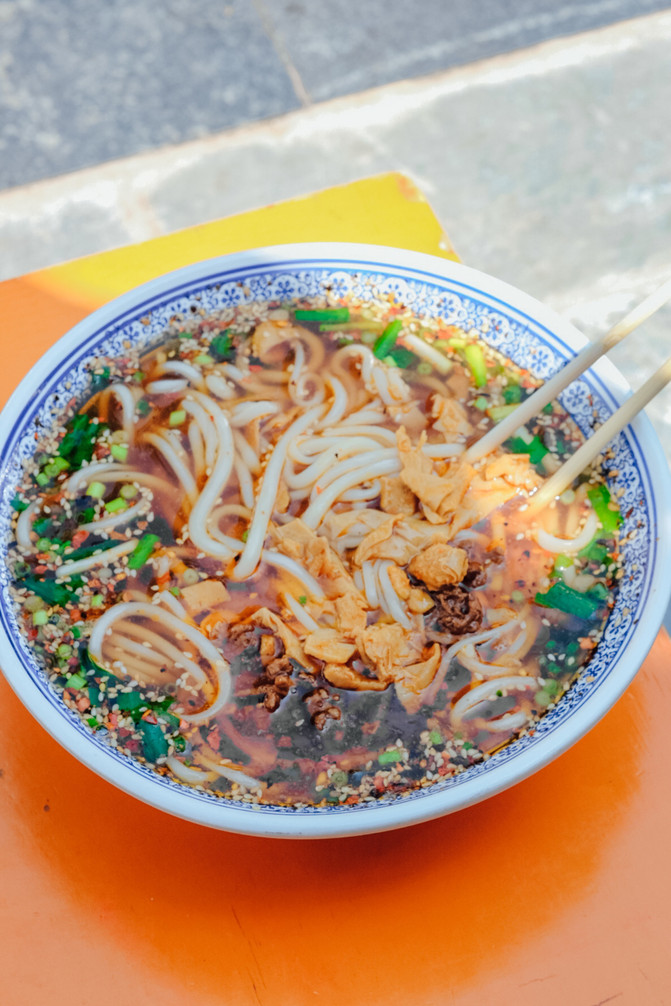
For example, the noodle that was published in "A Bite of China" recommended Zhu Ji's noodle and Su Lao San's noodle. Basically, they are eaten by locals and are no longer sold after noon;
Crossing the River Ersi is also very unique, but locals like to eat raked meat Ersi and recommend Lao Wang Crossing the River Ersi;
There is also a traditional Weishan old popsicle that you must also have. Walking on the street while eating popsicles while walking around the ancient city, that is called leisurely.
In addition, there are rolled noodles, roasted bait nuggets, fried stinky tofu, etc. They are cheap and delicious. It is not an exaggeration to call it a low-key food city.
"Si·Shaxi Ancient Town"-This is the ideal life
This is a place I wanted to go many times but was delayed for various reasons. This time I didn't miss it again.

The ideal of life is for the ideal life, and this worldly paradise located in Dali and Lijiang can be realized. It is Shaxi, one of my favorite ancient towns at present.

There is no chance to return to Dali and Lijiang 20 years ago, but now Shaxi still gives you a chance to cross through it.

Although the ancient town is small, it is small and exquisite. The "small bridges and flowing water families" in the south of the Yangtze River will have a different feeling in this land in the southwest. It is simple, simple, honest and original.

How can I say how it makes me feel? Use "shocking" to describe "tranquility"? Although it sounds weird, it really feels like that, isolated from the world and not adulterated with any impurities.
There is the smell of earth walls and soil in the air, and the sound of footsteps and hooves can be clearly heard, which makes people feel love and never forget it.

If you have enough time to come to Yunnan, then this place you must go!
? The secluded town of Shaxi Ancient Town, a secluded town in a paradise, has come from the ancient tea-horse road| Yujin Bridge
In ancient times, Shaxi was an important station on the ancient tea-horse road, and when you passed through Shaxi, you would definitely cross this bridge. It was Yujin Bridge.

The Yujin Bridge was originally an iron chain bridge. The "iron chain locks the river" is one of the four scenic spots in Shaxi. The bridge was destroyed when the iron chain was taken down and turned into weapons during the war chaos in the Xianfeng Year. The current semicircular single-hole stone bridge was raised from the 10th year of the Republic of China (1921) to the 24th year of the Republic of China (1935).
The word "Yujin" originated in the fifty-seventh year of Qianlong of the Qing Dynasty (1792). Shi Lifei wrote a couplet on the bridge;"Stone can become a bridge, and from now on, there will be no crossing without singing; Tianjin is really jade, and only then can we know that the water has its source."

From the existing "Introduction to Recruiting Yujin Bridge" written at Qiaotou by the famous Bai scholar Zhao Fan and Yang Yiqian, commander of the Chu Master District, we can see the important position of Yujin Bridge in the transportation location of the ancient tea-horse road at that time.

There is a river on the periphery of Shaxi Ancient Town called Heihui River. The width of this river is more than 20 meters. The river passes around Shaxi.

In ancient times, the two sides of this river were also the two sides of the Yujin Bridge. They were the most ideal resting place for the riders of the caravan. Many riders and pack horses watched the rising sun and moon here.

Yujin Bridge is also an ideal place for art students and art practitioners to paint. People come here every day to paint.

With the decline of the ancient tea-horse road, it was gradually forgotten, but because of its forgetting, it also better retains the appearance of the tea-horse town back then.
Crossing the gate of time| Nanzhai Gate
Nanzhai Gate is the most distinctive gate in Shaxi Ancient Town to me. The first time I saw it gave me the illusion that if I passed through it, there would be another world hidden.

On this side of the door is a relatively open space. Looking in through the door is a deep alley, which makes people feel curious.

In the past, the ancient Beizhaimen was destroyed in the years of wind, frost and war, leaving only Beiguzong Lane leading to Beizhaimen, while Nanzhai Gate leading to various salt wells in the south of Shaxi River.

Walking towards Nanzhai Gate, the first thing you enter is a bluestone alley. This alley is Nanguzong Lane. It is ancient and has many open shops.
Shaxi Cuisine
In terms of food, Shaxi has much less food than Weishan, and there are even fewer local snacks. You can try the sweet wine here.
The "Siyue Kitchen" next to Nanzhai Gate is quite good. You can recommend it. The most famous restaurant here,"First Seeing Shaxi Private Kitchen", I have never eaten it, but many friends recommend it. As for afternoon tea, I think it is more worth it because it is suitable for Shaxi's daze."Cosmic Bread","Match Coffee","Banshan Coffee","Raven Cafe", and "Leaf's Shop" are all worth checking in ~
Attachment 1 ·Private Storage Guide Dry Goods
- Map distribution of two ancient cities and two ancient towns

- About Car Rental
I think it is very suitable to rent a car in Dali, but it is the best choice if it is around the Erhai Lake!
Don't rent a car temporarily on the roadside or on the street. The risk is that the deposit is high and the performance cannot meet the standards.
When renting a car, carefully check the vehicle for damage. It is best to take a photo and record a video to avoid unnecessary disputes
Try to choose a third-party platform to rent a car. It will be more guaranteed. There will be no deposit for sesame points above 600.
Return the amount of oil you use when you use the car, and see clearly the amount of oil you use when picking up the car
Scratch insurance is generally 50 yuan/day. You still need to buy the insurance you should buy. Safety comes first.
If you are renting an electric car in the ancient city of Dali and nearby, it is generally 60 yuan/day
- 20 things to do when you come to Dali
? Go to Dali University to see cherry blossoms in spring
? Go to Tianlong Babu Film and Television City to experience the martial arts atmosphere
? Experience Zhoucheng tie-dyeing and make yourself a sail bag
? Take a photo with the three towers of Chongsheng Temple
? After staying in Xizhou Ancient Town for two days, I will know what peaceful years mean
? When you come to Dali, you must try roasted milk fans and Xizhou cakes
? Rent a car or ride around the Erhai Lake
? Ji Zhao Nuan eats vegetarian food and escapes into the mountains and forests
? Go to Cangshan to see azaleas
? Go to Shaxi Ancient Town to experience the simple Dali customs
? Find a bar anywhere at night and listen to folk songs
? When you are tired from walking, find a bookstore to read books and drink coffee in the ancient city of Dali
? Go to the street to have a barbecue at night, and the night is too exciting
? Watch a sunrise and sunset by Erhai Lake
? Rent an electric car and wander the streets aimlessly
? Go to Butterfly Spring to listen to "South of Colorful Clouds"
? Take a set of beautiful personal photos of yourself
? Find a favorite B & B and bask in the sun on the terrace
? Go to a deserted place to see seagulls flying from Siberia
? Don't rush your trip, sleep until you wake up naturally!
- precautions
1. Protect yourself from sun protection! Sunburn! Sunburn! important things say three times
2. The temperature difference in Dali is large, so if you go, the clothes you need to prepare are not only summer clothes, but also a coat.
3. If you go to Shaxi, be careful to turn slowly on sections with cliffs, because there are more trucks.
4. Remember to bring an umbrella when you go out, it will often rain in Dali
5. Don't wear uncomfortable shoes, never wear high heels
- Dali travel season
Winter cherry blossoms in January
There are spring cherry blossoms in March
Rape field from March to April
Sunflowers bloom from May to June
During the rainy season in Dali from July to October, there is a lot of rain, so bring an umbrella when traveling
From September to October, the rice fields are basically yellow
From November to March, seagulls will fly to Siberia from the north
Attachment 2 ·About the author
Leo boy in 1998, based in Chengdu.
In four years of college, I have traveled to 60 cities in 7 countries. Ctrip has contracted travelers and prefers niche attractions and natural lights in the cities. I hope to encounter wonderful and well-intentioned experiences. We will see you on the road after a long journey.

Previous Article:In late summer and early autumn, find the freedom of Dali together
Next Article:The starry sky in the double corridors and the wandering time in the Erhai Lake ~
